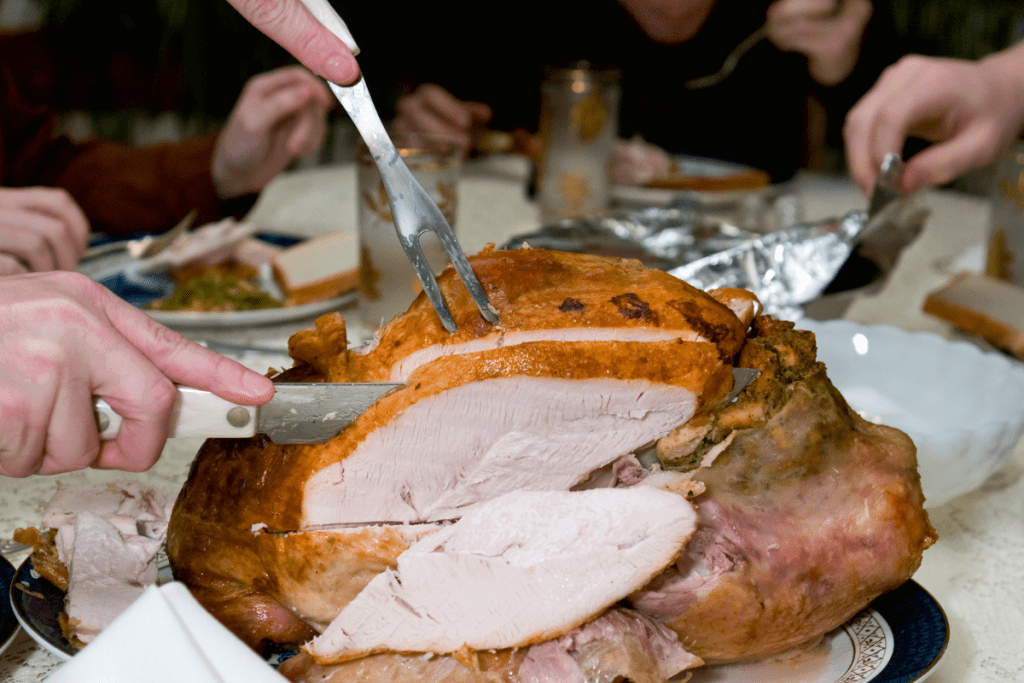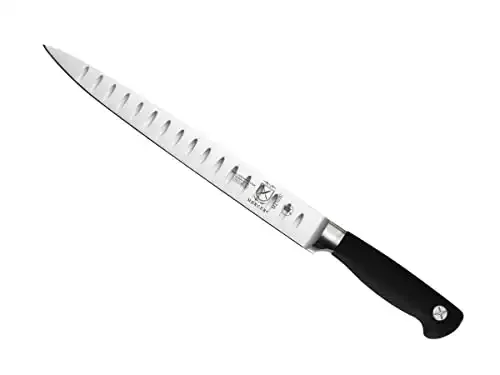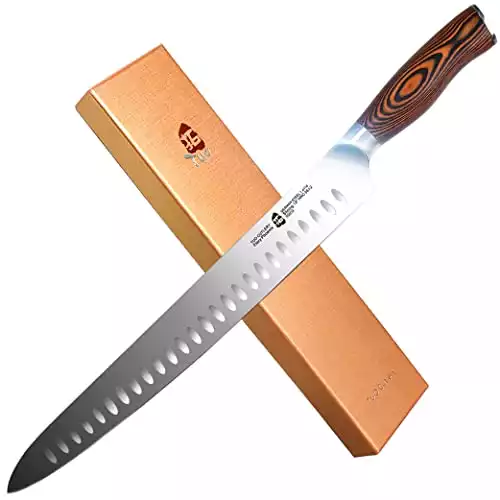Holidays wouldn’t be the same without everyone tucking into a big roast.
And whether your table is home to a honey glazed ham, juicy turkey, or succulent pot roast, you should have a carving knife close at hand.
Sure, you could make do without one of these specialized knives. Most of the year, they’ll live in your drawer. And I’ve found that most people have never actually used a “good” carving knife. Once you do, you’ll never want to go back to hacking through a roast with your chef’s knife.
I’ve tested, reviewed, and compared a baker’s dozen carving knives to put together this curated list of best carving knives for you. And if I’ve done well, by the time you’re finished reading you’ll know exactly why I always keep my trust carving knife within reach around the holidays.
In This Article
Our Top Picks
- Very affordable for the quality of its construction
- High carbon steel blade keeps a razor-sharp edge for months
- Long blade with full tang construction makes for smooth cuts
- Excellent steel quality for the price
- Long and sharp blade has great edge retention
- Best in class satisfaction guarantee and warranty
- The blade has the perfect amount of flexibility
- Excellent sharpness and edge retention
- Comfortable and well balanced
Best Overall: Mercer Genesis Collection 10 Inch Carving Knife
The Genesis series from Mercer Culinary makes top-quality knives available at a price any home cook can afford. That makes their carving knife an easy choice since most cooks won’t be looking to drop a lot of money on a knife they use a few times a year.
Even at such a low price, this knife delivers excellent performance. The high carbon stainless steel blade is sharp and has great edge retention. If you’re using this knife for holidays, I’d be surprised if you need to sharpen it within a year. And with its Granton edge blade, this knife makes for smooth and easy cuts.
The generous 10-inch blade for Mercer’s carving knife is made with a full tang construction, too. That means it’s not just sharp, but well-balanced and exceptionally durable. Cared for properly, it’s a knife that will last for decades.
Santoprene provides a hygienic and comfortable grip on this knife’s handle. It’s precision-molded for great ergonomics and fits well in hands of all shapes and sizes.
Lastly, all of Mercer’s Genesis series knives are covered by a limited lifetime warranty. As if it wasn’t affordable enough already, this guarantees that your investment is a safe one. Overall, it’s an awesome bargain that offers great performance.
What we like
- Very affordable for the quality of its construction
- High carbon steel blade keeps a razor-sharp edge for months
- Long blade with full tang construction makes for smooth cuts
What We don’t
- Some owners report problems with corrosion (this will be covered by the warranty)
Best Value: TUO 12 Inch Carving Knife
Cutlery newcomer TUO offers surprisingly high-quality knives at low prices. If you’re looking for a big carver that can handle the largest turkeys around, TUO has the knife for you. It’s a downright handsome knife, too, with an eye-catching pakkawood handle.
The TUO’s 12-inch blade is made of high carbon German stainless steel. That gives it excellent sharpness and edge retention, as well as resistance to rust and corrosion. Paired with a scalloped edge, this allows the knife to slice effortlessly through even the thickest of roasts.
Pakkawood, a wood fiber and resin composite, offers the best of hardwood looks and synthetic comfort. It’s easier to mold into an ergonomic handle shape and more hygienic to boot. I love the shape of TUO’s handle, and it has a good weight to it that provides balance to the long blade.
What really makes TUO’s carving knife stand out to me as my “best value” pick is their warranty and return policy. You can actually buy one of these knives, try it out, and return it for a full refund if you don’t like anything about it. When you do decide to keep it, though, it’s still covered by a lifetime warranty against defects.
What we like
- Excellent steel quality for the price
- Long and sharp blade has great edge retention
- Best in class satisfaction guarantee and warranty
What We don’t
- The 12-inch blade may feel unwieldy for some chefs
Best Upgrade: Wüsthof Classic 9 Inch Carving Knife
This knife is quite a bit more expensive than my other picks. But it has one big advantage: A more flexible blade. That’s in addition to every other aspect being spot-on, from the handle to the balance to the edge retention. The long-running German knife maker adds their signature attention to detail to every knife they make, including this carving knife.
Wusthof’s carbon steel blades are specially formulated with small additions of rare metals. That gives this knife a sharper edge that lasts longer and provides malleable flexibility. Why is that important for carving? Because it allows you to make precise cuts around bones and cartilage without lifting and repositioning your knife. The Granton edge complements this nicely, letting you make long and smooth slices with ease.
The synthetic polymer handle and sloped bolster give this carver a fine balance, and the 9-inch blade is easy for anyone to work with. Honestly, there’s nothing that I don’t like about this knife — except the price. If you have a larger kitchen budget to work with, or want to get a very nice gift for a loved one, I strongly recommend it.
What we like
- The blade has the perfect amount of flexibility
- Excellent sharpness and edge retention
- Comfortable and well balanced
What We don’t
- Expensive for a knife you won’t use often
Runners Up: Competitors to Consider
As much as I’d like to have my top three choices be the definitive word on carving knives, that’s not quite the case. There are a few more specialized cases where you may want to have one of the three other carving knives listed here.
An Excellent Carving Set: Messermeister Avanta 2 Piece Carving Knife and Fork Set
Messermeister’s Avanta series carving fork and knife are absolutely worth adding to your kitchen. The only reason I didn’t list them in my top picks is that the focus of this article is carving knives, not forks. And this knife only comes as part of a set. It has a good quality German steel blade, and comfortable pakkawood handles. Overall, a lovely set.
Alternative Upgrade: Zwilling J.A. Henckels Twin Four Star Slicing Knife
Falling somewhere between the price of my top and upgrade picks is Zwilling’s slicing knife. It uses a top-quality high carbon German steel that’s ice-hardened to increase its durability. And really, it has excellent sharpness and edge retention as well. The only reason I feature Wusthof as my upgrade pick instead is that Zwilling’s knife doesn’t have the same flexibility in its blade.
If You Must: Hamilton Beach Electric Knife
Electric carving knives exist. Are they the best option for carving your precious holiday roasts? No. They’ll often make a mess of perfectly good roasts that you’ve slaved over for hours. But if you absolutely must get an electric knife, Hamilton Beach offers the best performance for the price. Just don’t say I didn’t warn you.
Buyer’s Guide: How to Choose the Best Carving Knife
Choosing a carving knife is tough, in part because there’s no agreed-upon naming difference between carving and slicing knives. Add to that a growing list of inferior models, and you have a tough task ahead of yourself. But if you get to know the anatomy of a knife and compare it to my notes below, you’ll be fully informed and able to make the best decision for your kitchen needs.

Materials
Every knife is only as good as the materials it’s made of.
Choose inferior blade, handle, or bolster materials, and you’ll get poor performance. What constitutes top-quality materials, then?
Here’s what I look for in all of my knives, including carving knives:
- High carbon steel blades, preferably stainless. The better the steel quality, the sharper your knife will be and the longer it will hold an edge. Stainless treatments make your knives much easier to care for.
- Full tang construction. This means the metal used for the blade extends all the way through the handle. One-piece construction like this makes for durable and well-balanced knives.
- Solid and hygienic handles. Natural hardwood handles are beautiful but pricey. Synthetic composites are my choice most of the time, as they require very little special care or attention.
Handle
Above all else, the handle for a carving knife should be comfortable. And it’s one of the biggest areas where experienced knife producers win out over newcomers. Owing to their years of experience, older companies like Wusthof and Shun have refined their handle designs. That results in handles that are comfortable for the widest variety of people and have excellent grip.
Without being able to test a knife in person, deciding on the right handle style for you will be a challenge. When in doubt, I recommend checking the knife’s dimensions. Then, you can compare your hand size to the size of the handle and imagine how well it might fit.
Blade
The business end of a knife, the blade, gets the most attention for good reason. Even if you have a comfortable and well-balanced handle and bolster, a dull blade will sink your knife’s performance.
For carving knives, I look for these five qualities in their blades:
- Blade length will make or break a carving knife’s utility. Too short, and you’ll struggle to make clean cuts on large roasts. Too long, and the unwieldy blade will make it difficult to position yourself for cuts. I’ve found the sweet spot to be somewhere between 9 and 12 inches, with 10 inches feeling just right for almost everyone.
- Thickness should be kept to a minimum for carving knife blades. That allows the blade to slide effortlessly through roast meats.
- Flexibility is where you’ll see the biggest difference between affordable and expensive carving knives. And contrary to what you might expect, the pricier blades have more flexibility. This lets you slightly bend and maneuver the blade while making cuts, thereby avoiding bones and cartilage while still making a clean cut. For inflexible blades, you’ll need to reposition your knife to work around bones or cartilage.
- Weight should be directly related to the weight of the knife’s bolster and handle. This leads to my final, and perhaps most important, point:
- Balance is a combination of every other element in a carving knife, and a difficult quality to pinpoint. Ideally, the knife will feel almost weightless while you’re making cuts with it. That requires a sharp edge in addition to the blade, handle, and bolster existing in a dynamic balance.
Edge
Carving knives are expected to make smooth cuts through big pieces of meat. That means you’ll always want the sharpest edge possible! But there’s another piece to the puzzle: The Granton edge.
Also known as a scalloped edge, this addition to a carving blade creates tiny air pockets while you’re cutting. The result? Less friction on the blade, and less food sticking to it. I don’t use Granton edges for all of my knives, but carving and slicing knives seriously benefit from them.
Ergonomics
The longer a knife gets, the trickier it is to make it comfortable to use. That’s because the longer blades make a longer lever, which can put awkward pressure on your wrists and hands. The best carving knives prevent this by integrating a comfortable and well-balanced handle and bolster. Look for molded handles that fit the shape of your hand, not straight handles made of low-grade synthetic materials.
Care
Because you’ll be using a carving knife with less frequency than your other kitchen knives, care is both easier and more important. The last thing you want to do is leave your carving knife wet, or in a drawer with other kitchen tools! That’s a surefire way to turn your lovely knife into a nicked, rusted, and damaged blade.
Keep your knife dry in between uses, and store it safely. If you don’t have a dedicated knife drawer, consider keeping your carving knife in its original box. Or better yet, buy a knife block or magnetic knife hanger to save counter and drawer space.
Cost
How much do you really need to spend on a knife you’ll only be using a few times a year? Well, that’s up to you. In my top three picks, two knives are available for around $40, while the upgrade pick is over $100. If you have the extra money in your kitchen budget, upgrading will get you a much more visually pleasing knife. But if not, don’t hesitate to go for the $40 models.
Manual Vs Electric
The 1960s and 70s were wild years for home cooking. Jell-O molds reigned supreme, Ambrosia Salad was in vogue, and fondue pots were the center of house parties. Thank goodness we’ve (mostly) recovered from our cultural obsession with astronaut food.
That’s also when the electric knife made its debut on the holiday food scene. And just like each of the examples listed above, the electric knife hasn’t aged well. Will it cut through roast beef, ham, and poultry? Sure. Will it look pretty, or be easy to clean up? Absolutely not.
If you want to get the best out of your roasts, it will serve you well to learn how to use a manual carving knife. The best carving knives make easy, clean cuts, and are simple to clean. And you don’t even have to be near an outlet to use them.
Frequently Asked Questions About Carving Knives
As we close in on my final recommendations, let’s take a moment to go over the most common questions people have about carving knives. Beginners will find plenty of information to chew over here, while experienced cooks can use it to hone their knowledge of kitchen knives.
What Is A Carving Knife?
The carving knife’s purpose is contained within its name: Carving! But carving what? Large cuts of meat and poultry, mainly.
Carving knives were developed at nearly the same time as traditional chef’s knives. Often, the two were used interchangeably. But as kitchen skills progressed, the two knives grew further apart in their appearance and purpose.
Chef’s knives now feature a taller, thicker, and heavier blade. Carving knives, on the other hand, specialize in long, thin, and lightweight blades. That makes chef’s knives better all-purpose tools, and carving knives better for precise cuts on roast meats.
What’s the Difference Between A Carving Knife and A Slicing Knife?
When you’re shopping for a knife to carve your next holiday roast with, you might notice both carving and slicing knives in the product listings. What gives?
Well, the problem is that there’s no agreed-upon distinction between a carving and a slicing knife. Even so, the chefs I have worked with differentiate the knives like this:
Carving blades taper to a point, which is better for maneuvering around bones and cartilage.
A slicing knife has a rounded tip and no taper. They’re better for slicing very delicate things, like fish filets and terrines.
How Do You Sharpen A Carving Knife?
You can sharpen your carving knife just as you would any other kitchen knife. With practice, a whetstone will let you fine-tune the edge angle for your knives. If you’re not comfortable with that, I’d recommend taking your knife to be professionally sharpened. Electric sharpeners, while popular, will often decrease your knife’s longevity.
What Other Knives Should I Have In My Kitchen?
You certainly can’t use a carving knife for all your kitchen jobs. But how many knives do you really need? I always recommend starting out with a chef’s knife and a paring knife. That combo will take care of 90% of all the cuts you need to make in a kitchen. From there, I’d encourage you to read over my guide to the essential kitchen knives every home cook should have.
My Recommendations
Which of the knives listed above do you think is best for your kitchen? To recap, here’s why I think each one of them deserves a place on your knife rack:
The Mercer Genesis Collection 10 Inch Carving Knife offers top-notch performance at a bargain price. It’s made with quality German steel and features a hollow ground blade for easy carving. I’d recommend this knife to 90% of home cooks.
The TUO 12 Inch Carving Knife is large and in charge, but still reasonably priced. The pakkawood handle looks great, and the German steel blade is sharp and durable. It may be a little bit too long for some cooks, though.
Wüsthof’s Classic 9 Inch Carving Knife is a gorgeous kitchen tool with finely tuned performance. Its flexible blade makes it unmatched in precision carving potential. If it weren’t so expensive, it would easily be my top pick. Anyone with the budget for this knife will love the attention to detail put into it.










